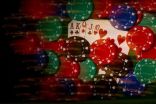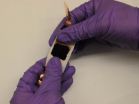(Press-News.org) (Santa Barbara, Calif.) –– While some theoretical physicists make predictions about astrophysics and the behavior of stars and galaxies, others work in the realm of the very small, which includes quantum physics. Such is the case at UC Santa Barbara, where theoretical physicists at the Kavli Institute for Theoretical Physics (KITP) cover the range of questions in physics.
Recently, theoretical physicists at KITP have made important strides in studying a concept in quantum physics called quantum entanglement, in which electron spins are entangled with each other. Using computers to calculate the extreme version of quantum entanglement –– how the spin of every electron in certain electronic materials could be entangled with another electron's spin –– the research team found a way to predict this characteristic. Future applications of the research are expected to benefit fields such as information technology.
"Quantum entanglement is a strange and non-intuitive aspect of the quantum theory of matter, which has puzzled and intrigued physicists since the earliest days of the quantum theory," said Leon Balents, senior author of a recent paper on this topic published in the journal Nature Physics. Balents is a professor of physics and a permanent member of KITP.
Quantum entanglement represents the extent to which measurement of one part of a system affects the state of another; for example, measurement of one electron influences the state of another that may be far away, explained Balents. In recent years, scientists have realized that entanglement of electrons is present in varying degrees in solid materials. Taking this notion to the extreme is the "quantum spin liquid," a state of matter in which every electron spin is entangled with another.
Balents said that quantum spin liquids are being sought in experiments on natural and artificial minerals. A key question posed by physicists is how to calculate theoretically which materials are quantum spin liquids. "In our paper, we provide an answer to this question, showing that a precise quantitative measure of 'long-range' entanglement can be calculated for realistic models of electronic materials," said Balents.
"Our results provide a smoking gun signature of this special type of entanglement that determines whether or not a given material is a quantum spin liquid," explained Balents. The results prove that an emblematic example of this type of problem –– material with electron spins residing on the "kagome lattice" –– is indeed a quantum spin liquid, according to Balents. The kagome lattice is a pattern of electron spins named after a type of Japanese fishing basket that this arrangement of spins resembles.
"We expect the technique we developed to have broad applications in the search for these unique quantum states, which in the future may have remarkable applications in information technologies," said Balents.
INFORMATION:
Hong-Chen Jiang, postdoctoral fellow with KITP, and Zhenghan Wang, a researcher with Microsoft Station Q at UCSB, are co-authors of the paper.
UCSB physicists make strides in understanding quantum entanglement
2012-12-15
ELSE PRESS RELEASES FROM THIS DATE:
Raising the blockade
2012-12-15
At crucial points in the metabolism of all organisms, a protein with the unwieldy name of Translation Elongation Factor P (EF-P, for short) takes center stage. What it actually does during protein synthesis has only now been elucidated – by researchers at Ludwig-Maximilians-Universität in Munich.
The research group led by Kirsten Jung, Professor of Microbiology at LMU, actually focused on how bacteria cope with stress, for example how the receptor meolecule CadC monitors the acidity in the environment and alerts the cell to take countermeasures to protect itself. However, ...
Physical constant passes the alcohol test
2012-12-15
This press release is available in German.
The mass ratio of protons and electrons is deemed to be a universal constant. And rightly so, as the latest radio-astronomy observations of a distant galaxy have shown. Scientists at the VU University of Amsterdam and the Max Planck Institute for Radio Astronomy in Bonn used the 100-metre radio telescope in Effelsberg to measure absorption lines of the methanol molecule at a number of characteristic frequencies. The researchers analysed the spectrum of the simplest of all the alcohols in a very distant galaxy. The result: to ...
Study questions reasons for routine pelvic exams
2012-12-15
The pelvic exam, a standard part of a woman's gynecologic checkup, frequently is performed for reasons that are medically unjustified, according to the authors of a UCSF study that may lay the groundwork for future changes to medical practice.
The research shows that many physicians mistakenly believe the exam is important in screening for ovarian cancer. The study, which surveyed obstetricians and gynecologists around the country, also shows that doctors continue to perform the exam in part because women have come to expect it.
The article is currently published online ...
New findings on killer bacteria's defence
2012-12-15
Antibodies are key to the recognition and neutralisation of bacteria by our immune system. The most common antibodies have the shape of a Y, and the two prongs fasten to molecules that belong to the bacteria. The cells in the immune system recognise the shaft and can then attack the bacteria.
Since the 1960s, it has been known that certain bacteria have developed the ability to turn these antibodies around, which makes it more difficult for the immune system to identify them. These include streptococcus bacteria, sometimes referred to as 'killer bacteria', that cause ...
More casinos does not mean more gamblers
2012-12-15
Memo to casino operators: just because you build it doesn't mean they will come.
A new study out of the University of Iowa examined how casino growth in the state has influenced gambling by residents. The survey suggests that fewer Iowans gambled overall and also that fewer people have become addicted to gambling despite a recent spurt in gaming facilities. Casino gambling was introduced in Iowa in 1991. There are currently 21 casinos in Iowa, all but three licensed by the state. (The others are owned and operated by Native American tribes.)
The findings could affect ...
Doing the right thing when things go wrong
2012-12-15
ANN ARBOR, Mich. — The University of Michigan Health System doesn't claim to be perfect. But its response to medical errors, near-misses, unexpected clinical problems and unintended outcomes is a model for the nation that other hospitals can and should copy, according to a new paper in a prestigious health care journal.
The "Michigan Model" for handling these situations, and preventing them from happening again, has not only helped patients and medical staff alike – it has also helped UMHS go against the grain of the costly, combative "deny and defend" medical malpractice ...
Stretchable electronics
2012-12-15
Electronic devices become smaller, lighter, faster and more powerful with each passing year. Currently, however, electronics such as cell phones, tablets, laptops, etc., are rigid. But what if they could be made bendable or stretchy?
According to the University of Delaware's Bingqing Wei, stretchable electronics are the future of mobile electronics, leading giants such as IBM, Sony and Nokia to incorporate the technology into their products.
Beyond traditional electronics, potential stretchable applications include biomedical, wearable, portable and sensory devices, ...
Drug to treat opioid addiction poses risks for accidental exposure to children
2012-12-15
(SALT LAKE CITY)—Buprenorphine is a safe and effective drug for treating opioid addiction. But as the prescribed use of buprenorphine has dramatically increased in recent years, accidental exposure of children to the drug has risen sharply, placing them at risk for serious injury and in extremely rare cases even death, according to researchers at the Utah Poison Control Center (UPCC), U School of Medicine's Department of Family and Preventive Health, and the Utah Department of Health (UDOH).
In a study published Thursday, Dec. 13, 2012, by the U.S. Centers for Disease ...
NASA sees Tropical Cyclone Evan batter and drench Samoan Islands
2012-12-15
NASA's Tropical Rainfall Measuring Mission or TRMM satellite continues to provide rainfall and cloud height data on powerful Cyclone Evan as it crawls through the Samoan Islands with hurricane-force winds and heavy rains. NASA's TRMM satellite identified "hot towers" in the storm, hinting that it would continue to intensify.
On Dec. 14, American Samoa, Tonga and Fiji are all under warnings or alerts as Evan continues to move west. A gale warning is in effect for Tutuila and Aunuu. A high surf warning is in effect for all of American Samoa. A flash flood watch is in effect ...
In decision-making, it might be worth trusting your gut
2012-12-15
Turns out the trope is true: You should trust your gut -- as long as you're an expert. So says a new study from researchers at Rice University, George Mason University and Boston College.
"How expert someone is within a particular domain has a positive impact on their ability to make an accurate gut decision," said Rice's Erik Dane, lead author of a study published last month in the journal Organizational Behavior and Human Decision Processes. However, he added, "Even if you're an expert, intuitive decision-making is better for some types of tasks than others. Tasks that ...





